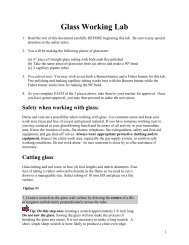Chapter 15: Solutions - Weironline.net
Chapter 15: Solutions - Weironline.net
Chapter 15: Solutions - Weironline.net
You also want an ePaper? Increase the reach of your titles
YUMPU automatically turns print PDFs into web optimized ePapers that Google loves.
Table <strong>15</strong>-5<br />
Molal Freezing Point<br />
Depression Constants (K f )<br />
Freezing K f<br />
Solvent point (°C) (°C/m)<br />
Water 0.0 1.86<br />
Benzene 5.5 5.12<br />
Carbon<br />
tetrachloride –23 29.8<br />
Ethanol –114.1 1.99<br />
Chloroform –63.5 4.68<br />
474 <strong>Chapter</strong> <strong>15</strong> <strong>Solutions</strong><br />
Values of K f for several common solvents are found in Table <strong>15</strong>-5. As with<br />
K b values, K f values are specific to their solvents. With water’s K f value of<br />
1.86°C/m, a 1m aqueous solution containing a nonvolatile, nonelectrolyte<br />
solute freezes at –1.86°C rather than at pure water’s freezing point of 0.0°C.<br />
However, in using the �T b and �T f relationships with electrolytes, you<br />
must make sure to use the effective molality of the solution. For example, one<br />
mole of the electrolyte sodium chloride (NaCl) forms one mole of Na + ions<br />
and one mole of Cl – ions in solution. Thus, a 1m aqueous NaCl solution produces<br />
two moles of solute particles in a kilogram of water—effectively acting<br />
as a 2m solution. Because of this, 2m, and not 1m, must be used in the<br />
�T b and �T f relationships for a 1m solution of sodium chloride. The following<br />
Example Problem illustrates this point.<br />
EXAMPLE PROBLEM <strong>15</strong>-6<br />
Changes in Boiling and Freezing Points<br />
What are the boiling point and freezing point of a 0.029m aqueous solution<br />
of sodium chloride (NaCl)?<br />
1. Analyze the Problem<br />
You are given the molality of an aqueous sodium chloride solution.<br />
First, calculate �Tb and �Tf based on the number of particles in solution.<br />
Then, to determine the elevated boiling point and the<br />
depressed freezing point, add �Tb to the normal boiling point and<br />
subtract �Tf from the normal freezing point.<br />
Known<br />
solute � sodium chloride (NaCl)<br />
molality of sodium chloride solution � 0.029m<br />
Unknown<br />
boiling point � ? °C<br />
freezing point � ? °C<br />
2. Solve for the Unknown<br />
Each mole of the electrolyte sodium chloride dissociates in solution to<br />
produce two moles of particles. Calculate the effective number of<br />
solute particles in solution.<br />
particle molality � 2 � 0.029m � 0.058m<br />
Substitute the known values for Kb , Kf , and particle molality into the<br />
�Tb and �Tf equations and solve.<br />
�Tb � Kbm � (0.512°C/m)(0.058m) � 0.030°C<br />
�Tf � Kfm � (1.86°C/m)(0.058m) � 0.11°C<br />
Add �Tb to the normal boiling point and subtract �Tf from the normal<br />
freezing point to determine the elevated boiling point and<br />
depressed freezing point of the solution.<br />
boiling point � 100.0°C � 0.030°C � 100.030°C<br />
freezing point � 0.0°C � 0.11°C ��0.11°C<br />
3. Evaluate the Answer<br />
The boiling point is higher and the freezing point is lower, as<br />
expected. Because the molality of the solution has two significant figures,<br />
both �T b and �T f also have two significant figures. Because the<br />
normal boiling point and freezing point are exact values, they do not<br />
affect the number of significant figures in the final answer.




